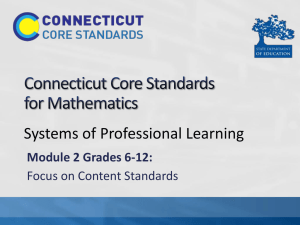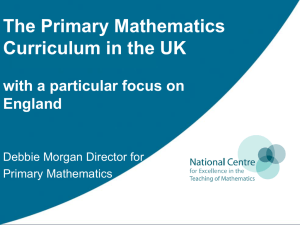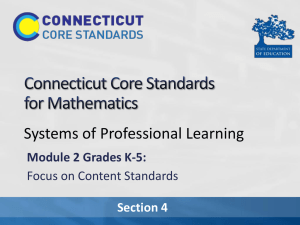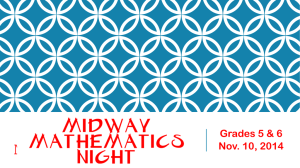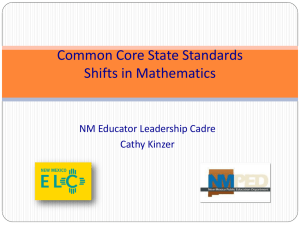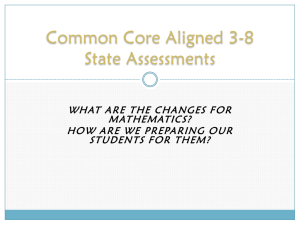Presentation - Connecticut Core Standards
advertisement
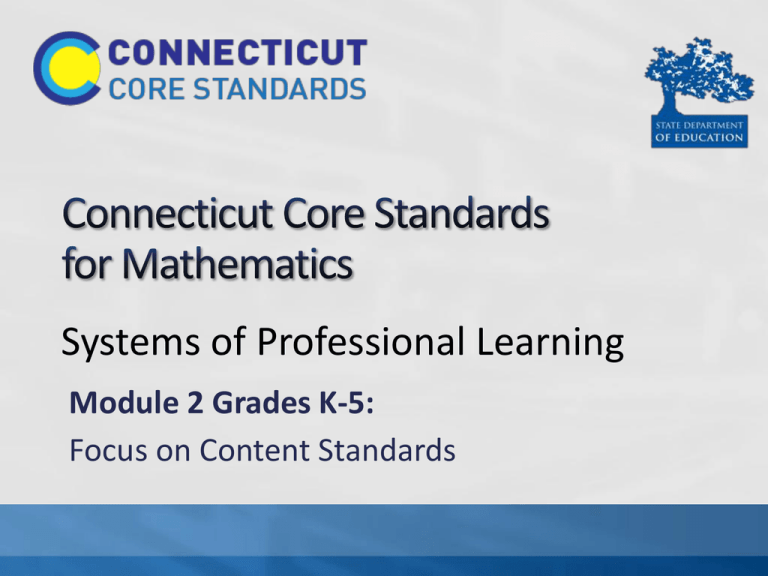
Systems of Professional Learning Module 2 Grades K-5: Focus on Content Standards By the end of this session you will have: Strengthened your working relationship with peer Core Standards Coaches. Deepened your understanding of the practice standards specified in the CCS-Math. Examined the implications of the language of the content standards for teaching and learning. Identified and modified CCS-aligned instructional tasks that combine both the content and practice standards. Analyzed the progression of topics in the content standards both within and across grade levels. 2 By the end of this session you will have: Deepened your understanding of the potential of the CCS-Math to change mathematics teaching and learning. Gained an understanding of some of the challenges involved in implementing the CCS-Math. Explored strategies for supporting teachers as they make changes to their classroom practices. Made plans for next steps in your CCS-Math implementation. 3 Morning Session Welcome and Introductions Sharing Implementation Experiences The Language of the Content Standards The Progression of the Content Standards Afternoon Session Meeting the Expectations of the Content Standards through Cognitively Rigorous Tasks Supporting Change Next Steps Post-Assessment, Session Evaluation, & Wrap Up 4 Please complete the Pre-Assessment Page 4 5 Section 1 Page 6 6 The Standards for Mathematical Content The Standards for Mathematical Practice Focus Coherence Two Areas Rigor 7 Focus Focuses on the major work for each grade level 8 Coherence The Standards are designed around coherent progressions and conceptual connections Grade 1 Use place value understanding and properties of operations to add and subtract Grade 2 Use place value understanding and properties of operations to add and subtract fluently Grade 3 Use place value understanding and properties of operations to perform multi-digit arithmetic 9 Coherence The CCS-Math are designed around coherent progressions and conceptual connections All Roads Lead to Algebra…… Math Concept Progression K-12 10 Rigor CONCEPTUAL UNDERSTANDING • More than getting answers • Not just procedures • Accessing concepts to solve problems The major topics at each grade level focus on: PROCEDURAL SKILL AND FLUENCY • Speed and accuracy • Used in solving more complex problems • Are built on conceptual understanding APPLICATION OF MATHEMATICS • Using math in realworld scenarios • Choosing concepts without prompting 11 The Standards for Mathematical Practice 1. Make sense of problems and persevere in solving them 2. Reason abstractly and quantitatively 3. Construct viable arguments and critique the reasoning of others 4. Model with mathematics 5. Use appropriate tools strategically 6. Attend to precision 7. Look for and make use of structure 8. Look for and express regularity in repeated reasoning 12 Sharing Implementation Experiences Positive Highlights 1. Each participant will discuss with their table group one Positive Highlight, one Challenge, and one Lesson Learned from their personal implementation of the Practice Standards thus far. 2. Each table group will then determine two Positive Highlights, one common Challenge, and one common Lesson Learned that they will present to the larger group. 3. Participants will record notes and “New Ideas” generated from the discussion. Challenges Lessons Learned Pages 6-7 Guide Pages 8-9 13 Section 2 Page 8 14 What Do These Students Understand? – Part 1 1. Read and analyze the “Who Knows Math” handout on page 9 in the Participant Guide. Record your observations on what these students know and what they can do on page 10 in the Participant Guide. 2. Would you be comfortable with his/her understanding if s/he continued to approach division in his/her particular way? Explain your reasoning. Pages 9-11 15 Watch Video 16 Rigor CONCEPTUAL UNDERSTANDING • More than getting answers The major topics at each grade level focus on: PROCEDURAL SKILL AND FLUENCY • Speed and accuracy • Not just procedures • Used in solving more complex problems • Accessing concepts to solve problems • Built on conceptual understanding APPLICATION OF MATHEMATICS • Using math in realworld scenarios • Choosing concepts without prompting 17 “Conceptual understanding refers to an integrated and functional grasp of mathematical ideas.” (Adding it Up: Helping Children Learn Mathematics. 2001) 18 Example CCSS.Math.Content.1.NBT.C.4 Add within 100, including adding a two-digit number and a one-digit number, and adding a two-digit number and a multiple of 10, using concrete models or drawings and strategies based on place value, properties of operations, and/or the relationship between addition and subtraction; relate the strategy to a written method and explain the reasoning used. Understand that in adding two-digit numbers, one adds tens and tens, ones and ones; and sometimes it is necessary to compose a ten. Question: What is 20 + 70? 19 Question: What is 20 + 70? Student Response: 20 is 2 tens and 70 is 7 tens. So, 2 tens and 7 tens is 9 tens. 9 tens is the same as 90. 20 Example Standard 2.OA.3: Determine whether a group of objects (up to 20) has an odd or even number of members, e.g., by pairing objects or counting them by 2s write an equation to express an even number as a sum of two equal addends. Question: Is 7 an even or odd number? Explain how you know. Student Response: 7 is odd because I cannot make pairs with all of the cubes like I can with 8 cubes. When I can make pairs with all of the cubes it is an even number. 21 “Procedural skill and fluency is demonstrated when students can perform calculations with speed and accuracy.” (Achieve the Core) “Fluency promotes automaticity, a critical capacity that allows students to reserve their cognitive resources for higher-level thinking.” (Engage NY) 22 Check all the equations that are true 8 x 9 = 81 54 ÷ 9 = 24 ÷ 6 7 x 5 = 25 8x3=4x6 49 ÷ 7 = 56 ÷ 8 Mariana is learning about fractions. Show how she can divide this hexagon into 6 equal pieces. Write a fraction that shows how much of the hexagon each piece represents. (PARCC 2013) (PARCC 2013) Adding / subtracting with tens [Ask orally] (a) Add 10 to 17 (b) Add 10 to 367 (c) Take 10 away from 75 (d) Take 10 away from 654 23 Standard 1.OA.6: Add and subtract within 20, demonstrating fluency for addition and subtraction within 10, use strategies such as counting on; making ten; decomposing a number leading to a ten; using the relationship between addition and subtraction; and creating equivalent but easier or known sums. Example Question: What is 5 + 6? Student Response: I know that 5 + 5 = 10; since 6 is 1 more than 5, then 5 + 6 must be 1 more than 10. 1 more than 10 is 11. 24 The Standards call for students to use math flexibly for applications. Teachers provide opportunities for students to apply math in authentic contexts. Teachers in content areas outside of math, particularly science, ensure that students are using math to make meaning of and access content. Frieda & Parker, 2012 Achieve the Core. 2012 25 Example There are 9 cookies left in the pan. Five students want to share the cookies equally. How many cookies will each student get? 26 What Do These Students Understand? – Part 2 Return to the “Who Knows Math” handout on pages 9-11 in the Participant Guide. Which students have shown conceptual understanding, which have shown procedural skill and fluency, which have shown both, and which pieces of work would you need to know more to make the determination? Pages 9-11 27 How does the approach of the CCSMath content differ from previous approaches to mathematics teaching and learning? How might you help teachers to understand these differences? 28 29 Section 3 Page 15 30 31 Source: http://www.definingthecore.com 32 For more Information: http://commoncoretools.me/category/progressions/ 33 Number and Operations in Base Ten Number and Operations in Fractions Counting and Cardinality & Operations and Algebraic Thinking Measurement and Data Geometry 34 Part 1 Examine your assigned domain and determine which standards focus on: • Conceptual Understanding (CU) • Procedural Skill and Fluency (PSF) • Application (A) 4.NBT.4 Fluently add and subtract multi-digit whole numbers to any place. Page 15 35 Part 2 Examine your assigned domain across the K-5 grade band and record five general observations about the progression and two observations about the relationship between the Content and Practice Standards. 1.NBT.2a Understand that numbers from 11 to 19 are composed of a ten and one, two, three, four, five, six, seven, eight, or nine ones. Guide Page 16 Pages 14-15 36 Part 3 Examine all of the Content Standards for your assigned grade level. Make connections across domains and create clusters that can be taught as part of a lesson or unit. 3.MD.8 Solve real world and mathematical problems involving perimeters of polygons, including finding the perimeter given the side lengths, finding an unknown side length, and exhibiting rectangles with the same perimeter and different areas or with the same area and different perimeters. Guide Page 17 Pages 14-15 37 Watch Video 38 How might you help teachers at your school to fully understand the progressions of the content standards? What questions do you anticipate teachers having about the content standards? Page 18 39 40 Section 4 Watch Video 42 Ron’s Recycle Shop was started when Ron bought a used paper-shredding machine. Business was good, so Ron bought a new shredding machine. The old machine could shred a truckload of paper in 4 hours. The new machine could shred the same truckload in only 2 hours. How long will it take to shred a truckload of paper if Ron runs both shredders at the same time? (Van de Walle, Karp, & Bay-Williams, 2012) 43 13 miles = 1 square mile 9 deer in each 8 miles A ranger estimates that there are 9 deer in each square mile of the park. If this estimate is correct, how many total deer are in the park? 1. What is the area of the park? 2. How many are in the park? 3. How many total deer are in the park? 44 13 miles = 1 square mile 9 deer in each 8 miles A ranger estimates that there are 9 deer in each square mile of the park. If this estimate is correct, how many total deer are in the park? 45 13 miles 8 miles A ranger estimates that there are 9 deer in each square mile of the park. If this estimate is correct, how many total deer are in the park? 46 The perimeter of the rectangular state park shown is 42 miles. A ranger estimates that there are 9 deer in each square mile of the park. If this estimate is correct, how many total deer are in the park? Explain your answer using numbers, symbols, and words. 47 How can I help teachers incorporate cognitively rigorous mathematics tasks that will benefit ALL students? 48 Scaffolding Open Questions Parallel Tasks C-R-A Page 22 49 Five friends ordered 3 large sandwiches. James ate ¾ of a sandwich. Katya ate ¼ of a sandwich. Ramon ate ¾ of a sandwich. Sienna age ½ of a sandwich. How much sandwich is left for Oscar? What can be added to the problem? What can happen during the implementation? 50 Example 1: The answer to a division problem is 10. What numbers did you divide to get this answer and what word problem might you have been solving? Example 2: Andrew ate ______ of the pizza and had _____ left over. Olivia ate ½ of the leftovers and gave the rest to Michael. How much pizza did Michael get to eat? 51 Example 3: Create a word problem that can solved by adding two fractions. Example 4: Fill in the numbers that will make the equation true. 9 + ____ = _____ ____ + 5 = _____ 10 + ___ = _____ 52 Example 1 Choice 1: Create an equation that requires you to add two 3-digit numbers. How can you tell if your equation is true? Choice 2: Create an equation that requires you to add two 2-digit numbers. How can you tell if your equation is true? 53 Example 2: Create a word problem for one of these equations. Choice 1: 9 x 5 = 45 Choice 2: 18 x 3 = 54 Choice 3: 23 X 4 = 92 54 Concrete Representational Abstract 55 Order the following fractions from smallest to largest: 3 8 1 3 5 9 2 5 Explain your reasoning Retrieved from Illustrative Mathematics http://www.illustrativemathematics.org/ 56 Illustrative Mathematics http://www.illustrativemathematics.org/ Achieve the Core http://achievethecore.org/ Smarter Balanced http://smarterbalanced.org/ Mathematics Assessment Project http://map.mathshell.org/materials/index.php 57 1. What other sites/materials do you know of that are good resources for cognitively rigorous tasks? 2. How do cognitively rigorous tasks relate to conceptual understanding, procedural skill and fluency, and application of mathematics? 3. How do cognitively rigorous tasks help students to develop the mathematical expertise in the Standards for Mathematical Practice? Page 23 58 59 Section 5 Page 25 60 Watch Video 61 Watch Video 62 Group 1: Journals Group 2: Mathematical Language Group 3: Fluency Group 4: Group Work & Decision Making 1. How can this strategy/resource support the CCS-Math content and practice standards? 2. Generate at least one new idea for the use of Pages 27-28 the strategy/resource with students. 63 Page 41 64 By the end of this session you will have: Strengthened your working relationship with peer Core Standards Coaches. Deepened your understanding of the practice standards specified in the CCS-Math. Examined the implications of the language of the content standards for teaching and learning. Identified and modified CCS-aligned tasks that combine both the content and practice standards. Analyzed the progression of topics in the content standards both within and across grade levels. 65 By the end of this session you will have: Deepened your understanding of the potential of the CCS-Math to change mathematics teaching and learning. Gained an understanding of some of the challenges involved in implementing the CCS-Math. Explored strategies for supporting teachers as they make changes to their classroom practices. Made plans for next steps in your CCS-Math implementation. 66 Where Are You Now? Assessing Your Learning. Please complete an online Session Evaluation. Your feedback is very important to us! http://surveys.pcgus.com/s3/CT-Math-Module-2-K-5 67
